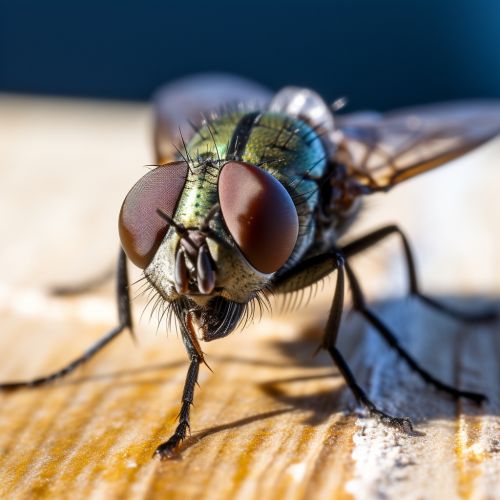Haltere
Overview
The Haltere is a specialized organ found in the order of insects known as Diptera, which includes flies, mosquitoes, and gnats. These organs are unique to Diptera and play a crucial role in their flight mechanics and balance. They are small, club-shaped appendages located behind the wings and oscillate in the same plane as the wings during flight.


Structure and Function
Halteres are derived from the hind wings of the insect during the evolutionary process. They consist of a stalk (or pedicel) and a knob (or capitulum), which is typically heavier and contains most of the sensory organs. The capitulum is covered with tiny sensory hairs, or mechanoreceptors, which detect changes in air pressure and movement.
The primary function of the haltere is to assist in maintaining balance and stability during flight. They achieve this by acting as a type of gyroscopic stabilizer. When the insect changes direction or orientation, the halteres respond to the change in angular momentum, providing feedback to the insect about its body position. This information is then used to make rapid adjustments to the wing movements, ensuring stable and controlled flight.
Evolution
The evolution of halteres from wings is a fascinating example of evolutionary biology. It is believed that the ancestors of Diptera had two pairs of wings, similar to most other insects. However, over time, the hind wings evolved into halteres, providing Dipterans with a unique flight mechanism.
This transformation is thought to have provided an evolutionary advantage, allowing Dipterans to perform complex aerial maneuvers and evade predators more effectively. The development of halteres is a remarkable example of how evolution can repurpose existing structures for new functions, a concept known as exaptation.
Role in Flight Mechanics
The role of halteres in flight mechanics is complex and multifaceted. They oscillate in the same plane as the wings, but in the opposite phase. This means that when the wings are at the top of their stroke, the halteres are at the bottom, and vice versa. This counter-oscillation helps to stabilize the insect during flight.
Halteres also play a crucial role in the insect's ability to perform rapid maneuvers. When the insect wants to change direction, it modifies the stroke amplitude or frequency of its wings. The halteres detect these changes and provide feedback to the insect's nervous system, which then adjusts the wing movements accordingly.
Sensory Mechanisms
The sensory mechanisms of halteres are complex and not fully understood. The base of the haltere contains mechanoreceptors, which detect changes in the haltere's position and movement. These mechanoreceptors are connected to the insect's nervous system and provide constant feedback about the insect's body position and movement.
In addition to mechanoreceptors, halteres also contain chordotonal organs, which are internal stretch receptors. These receptors detect changes in the length and tension of the haltere, providing additional sensory information to the insect.
Research and Applications
Research into halteres has potential applications in the field of micro air vehicles (MAVs). By understanding how halteres function and contribute to the extraordinary flight capabilities of Diptera, scientists hope to design more efficient and maneuverable MAVs.
In addition, halteres could also provide insights into the evolution of flight in insects and other animals. By studying the structure and function of halteres, researchers can gain a better understanding of how flight mechanisms have evolved and adapted over time.
